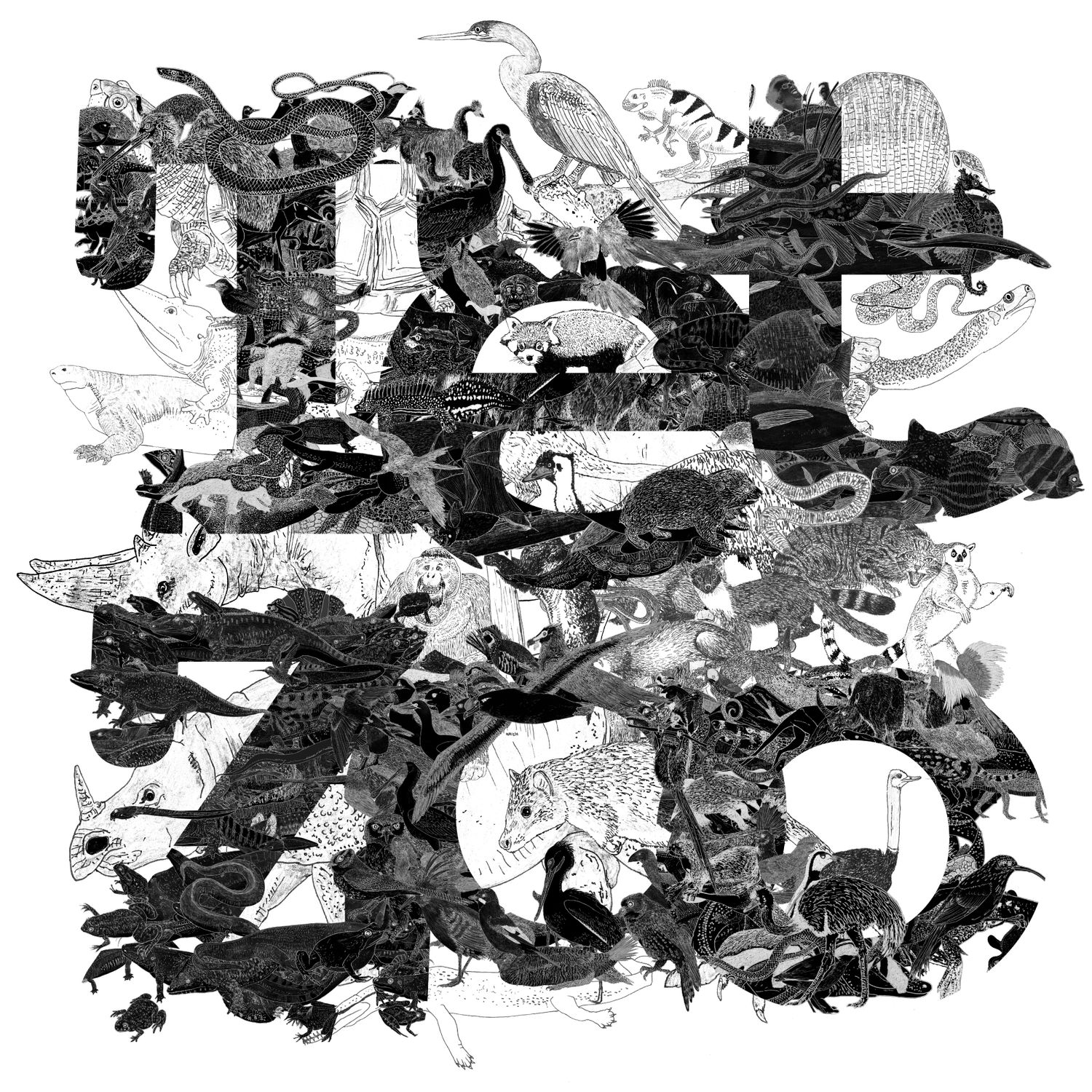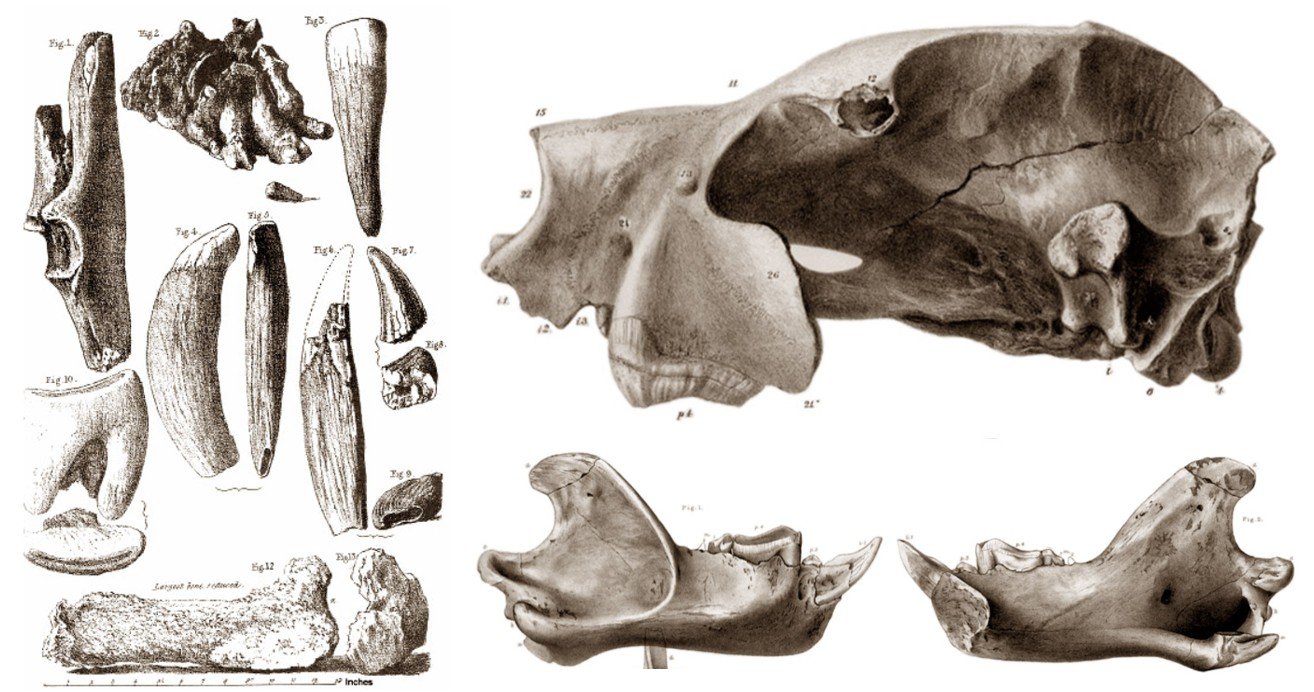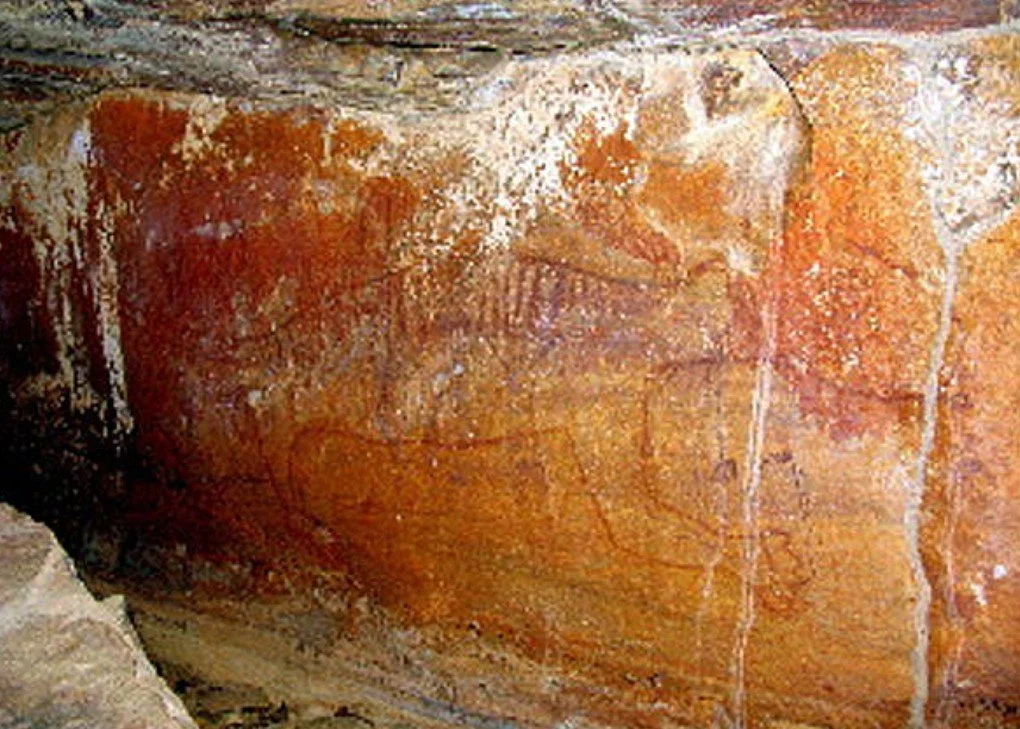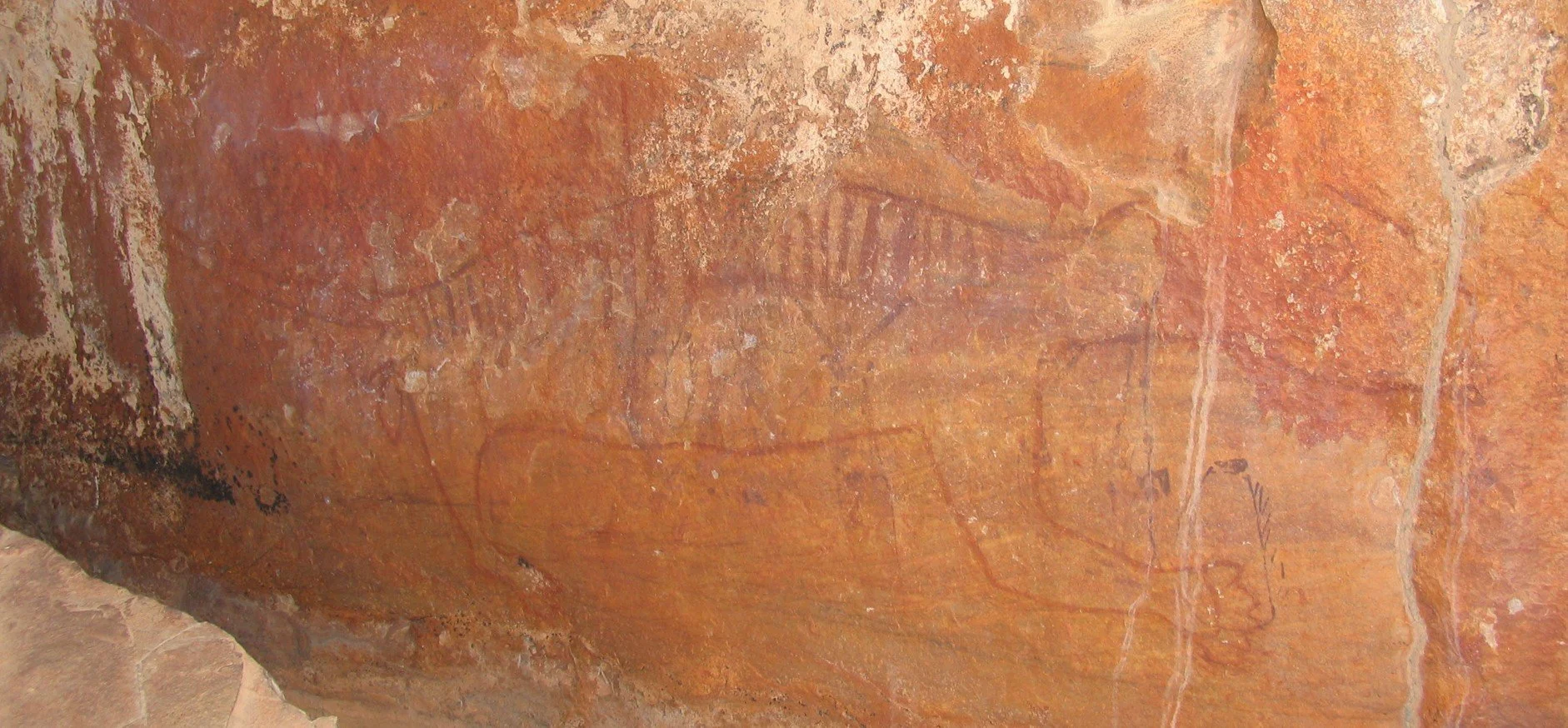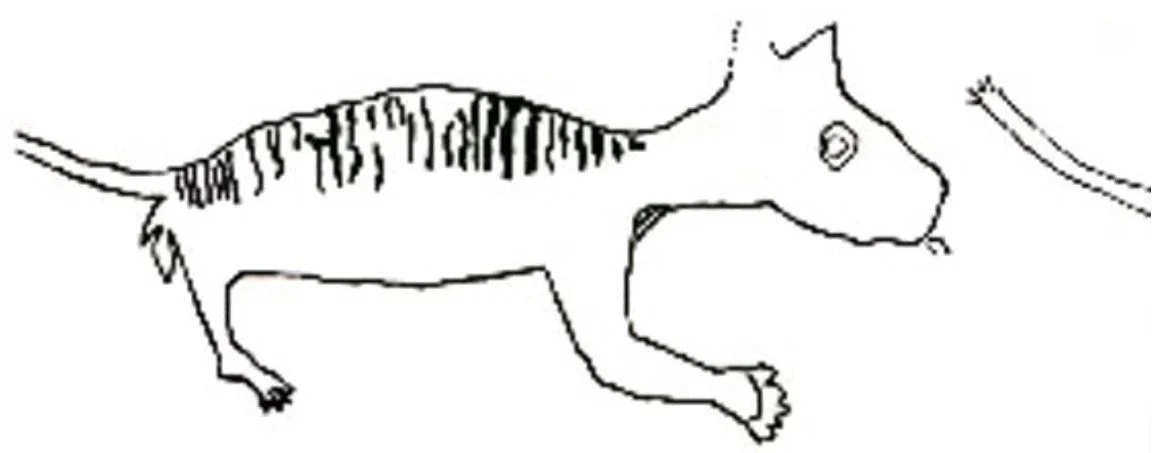Among the most striking and interesting of extinct mammals is the so-called marsupial lion of Australia, or Thylacoleo carnifex…
Caption: artists have struggled to reconstruct Thylacoleo, in part because they haven’t had a clear guide on which marsupial to use as a model. Some of the reconstructions here, like Richard Orr’s at upper left and Peter Snowball’s at bottom left, don’t quite look like any living marsupial; Frank Knight’s reconstruction in the middle is possum-like; Graham Allen’s at upper right is substantially too lion-like; finally, Jaime Chirinos’s image at lower right does make it look like a diprotodontian marsupial of some sort.
A lion-sized predator whose fossils are known from Western Australia, Northern Territory, South Australia, Queensland, New South Wales and Victoria – that is, from right across the country – Thylacoleo had a remarkably powerful skull and very strong bite (Wroe et al. 2005) and extremely odd teeth when compared to placental predators like big cats. It was big, data from several specimens showing that it was mostly between 100 and 160 kg and thus similar in mass to female lions and tigers (Wroe et al. 1999).
Caption: various images showing this skeleton, on show at Naracoorte Caves National Park in South Australia, are available online; this is a cropped version. It’s misleading in showing the animal at an angle such that its body looks very short and its face is mostly directly away from us, plus it doesn’t have a tail, but it shows the relatively long limbs but short feet and massive thumbs of this animal. Image: Karora, public domain (original here).
The European discovery of Thylacoleo. Today we have reason to think that Thylacoleo was known to prehistoric indigenous people, but in terms of the scientific, European perspective, it first became known during the 1830s, initially thanks to the discovery of teeth and other fragments from Wellington Valley in New South Wales. These must have been tantalising and frustratingly enigmatic, since they hinted at the presence of a giant predatory mammal that didn’t match anything known to science.
Caption: key early Thylacoleo discoveries. At left, the assortment of teeth and other fragments reported from Wellington Caves in New South Wales by Major Thomas Mitchell in 1838. At upper right, the very nice near-complete skull from Darling Downs, Queensland, lacking its zygomatic arch, described by Owen in 1866 and passed to him by Edward Hill and Daniel Cooper. At lower right, lateral (left) and medial (right) views of the right hemimandible from Wellington Caves described by Owen in 1886.
Better remains discovered at Lake Colongulac in Victoria in 1845 and Darling Downs in Queensland at some (unstated) point in the 1860s ultimately revealed what the skull and dentition looked like. These were then sent to England where they were studied by Victorian anatomist, biologist and palaeontologist Richard Owen. Owen published several contributions on this animal over his career, the most important being his article of 1859 since this is where he both named it and properly described it in anatomical terms (Owen 1859).
Caption: replica Thylacoleo skull on show at the Grant Museum of Zoology, London. The projecting and vaguely beak-like form of the incisors, massive size of the third upper premolar, and great depth of the zygomatic arch are all obvious. Image: Darren Naish.
Owen recognised Thylacoleo as a marsupial but thought it might be allied to dasyures, in particular the Tasmanian devil Sarcophilus harrisii. It was soon considered allied to phalangers, the marsupial group that includes brushtail possums and cuscuses. Vertical striations on the blade-like premolars made it clear that these teeth had a shearing role and most likely functioned in carnivory, and hence Owen proposed that Thylacoleo was a remarkable carnivore and a particularly formidable one at that, perhaps “one of the fellest and most destructive of predatory beasts” (Owen 1859, p. 319).
But this view was so radically odd – a carnivorous relative of the folivorous and frugivorous phalangers – that others contested it (e.g., Cope 1882, Anderson 1929). Surely it was more likely that this animal was a herbivore, frugivore or even ovivore, perhaps specialised for a diet of nuts, hard-skinned fruit like melons, or large eggs. Owen contested claims of this sort published during his lifetime (he died in 1892) but supposed issues with the carnivorous notion were still being published as late as the 1960s. The idea that it might have been a bone-cracking scavenger was also suggested by those claiming that it just couldn’t have been a predator.
Caption:Thylacoleo is no longer enigmatic or poorly known when it comes to our knowledge of skeletal anatomy, since we have near-complete skeletons. This montage, from Wells & Camens (2018), shows (A) the Flight Star Cave specimen from Nullarbor Plain, Western Australia, and (B and C) two additional individuals from Komatsu Cave, Naracoorte, South Australia. Images: Clay Bryce and S. Bourne, from Wells & Camens (2018), CC BY 4.0
Finds made during the 1960s and 70s, the best ones involving near-complete skeletons, revealed the remarkable anatomy of the hand (Wells & Nichol 1977) and also provided more data for an active, predatory lifestyle: abundant, deep, V-shaped incisions made on kangaroo and Diprotodon limb bones and ribs found in Lancefield, Victoria, can only have been made by Thylacoleo (Horton & Wright 1981). Nedin (1991) analysed strontium and zinc levels in Thylacoleo bones and found them to match levels present in modern predatory and insectivorous marsupials… and Thylacoleo certainly wasn’t an insectivore.
Caption: two competing reconstructions of Thylacoleo, one showing it eating fruit and one showing it as a predator of other marsupials, were included by Kurtén (1971) in his The Age of Mammals. The nondescript limb proportions and very normal paws featured here make the animal look quite bland relative to what we now understand. Images: Margaret Lambert, from Kurtén (1971).
Other thylacoleonids. Where does Thylacoleo belong in phylogenetic and taxonomic terms? It’s the type genus for its group, namely Thylacoleonidae, the fossil record of which goes back to the Upper Oligocene. Other members of the group include Microleo attenboroughi* and Enigmaleo archeri, both from the Miocene of Riversleigh in Queensland, both of which were similar in size to tree squirrels. Then there are the several species of Wakaleo from the Late Oligocene and Miocene of widespread locations across Australia. Wakaleo species ranged from similar to a house cat in size to an estimated 50 kg, which is equivalent to a large leopard (Warburton & Yates 2021). Lekaneleo is an Oligo-Miocene taxon previously treated as a species of Wakaleo (and before that, included in the now defunct Priscileo).
* Taxon number 27165 named after David Attenborough. I mean no slight to Sir David, but come on.
Finally, I should note that a few Thylacoleo species other than T. carnifex have been named, these being T. hilli and T. crassidentatus, both from the Pliocene and both somewhat smaller than T. carnifex.
But where within Diprotodontia? A list of anatomical traits in the dentition and across the skeleton show that thylacoleonids are part of the great marsupial group Diprotodontia, the clade that also includes possums, phalangers, wombats, koalas, the extinct diprotodontids and kin, in addition to macropods (the kangaroos and wallabies). I’ve written about diprotodontian diversity and phylogeny here at Tet Zoo in the past (2011 to be precise) but, as ever, those articles have been ruined by their hosters in the interim and now need to be rescued and republished here. >>>Sigh<<<. Currently, there’s a dearth of marsupial content here and that’s something I need to fix.
Anyway, several different ideas exist on where thylacoleonids belong within the diprotodontian clade, some of these placing them within Vombatiformes (the koala + wombat clade), a possibility hinted at by similarities in ankle anatomy (Szalay 1994). An early-diverging position within Diprotodontia as a whole has also been favoured, this time partly driven by the fact that thylacoleonids like Lekaneleo are archaic in skull anatomy relative to other diprotodontians (Beck et al. 2022).
Caption: molecular phylogeny for marsupials (and a few other mammals) and incorporating ancient collagenous DNA data from several extinct data, from Buckley et al. (2025) but incorporating some illustrations. Macropods (kangaroos) are the biggest and most diverse diprotodontian clade; note that thylacoleonids and koalas belong here in a clade with wombats, diprotodontids (like Zygomaturus) and palorchestids. Image: Buckley et al. (2025); drawings by Darren Naish.
In their big analysis of marsupial phylogenetic history, Robin Beck and colleagues made the prediction that the Pleistocene age of Thylacoleo made it plausible that DNA data might one day have a bearing on this issue (Beck et al. 2022, p. 227). That time has come, for recently published genetic data – yes, palaeogenomic data does now exist for Thylacoleo – indicates a close relationship with koalas, properly Phascolarctidae (Buckley et al. 2025), in which case thylacoleonids are within Vombatiformes after all.
An anatomical summary. Thylacoleo is well known for possessing a radically odd, striking dental anatomy that combines enlarged, caniniform incisors with extremely long, blade-like premolars built for slicing. The incisors are so large and prominent that some writers of the past imagined this animal to have a projecting parrot-beak, an idea sometimes erroneously linked to a diet of fruit or nuts. Small and (presumably) functionally unimportant upper canines are present, but lower ones are lacking.
Caption: nice, clean illustrations of the Thylacoleo dentition, showing (at top) the upper jaw in left lateral and ventral or palatal view, and the left hemimandible in lateral view, from Molnar (1999). At right, two skeletal reconstructions, the lower one produced to show a musculature and integument based on that seen in x-rays of extant marsupials, from Wells & Camens (2018). Images: Ralph Molnar; Wells & Camens (2018), CC BY 4.0
The forelimb is robust with large muscle attachments, especially in the elbow region and top of the upper arm, and the hand is remarkable, in particular because of the proportionally large, semi-opposable thumb and massive ‘hood’ for attachment of a large, curved claw. It looks likely that this was used to help grasp branches during climbing, the animal presumably using an alternating, ‘hand over hand’ climbing style like that used by possums and koalas. The massive thumb was perhaps also deployed as a pinning or grabbing tool when subduing prey. The range of motion possible in the thumb indicates that it could be raised high off the ground (if we imagine a pose where the other digits and the heads of the metacarpals are pressed against it) and also flexed to be tucked behind the palm when not needed. Possible Thylacoleo tracks involve four digits and the anterior edge of a rounded palmar pad, so are consistent with this possibility (Carey et al. 2011).
Caption: the Thylacoleo manus, showing the massive size and highly mobile nature of the thumb (pollex). This image is from Janis (2024)… and is based on one in Figueirido et al. (2016)… which was based on one in Wells & Nicholl (1977).
Caption: these broad, tetradactyl tracks from Pleistocene sediments of the Victorian Volcanic Plains site might be forelimb tracks made by a thylacoleonid, but they might not be. Whatever made them, it had rounded pads at the end of its digits and subrectangular pads beneath the main length of each digit. The scale bar isn’t labelled but must be 10 cm. Image: Carey et al. (2011).
The hindlimbs are stocky with a short metatarsal section that results in the ankle being close to the ground, so Thylacoleo was probably plantigrade or just about so. The hindfeet were narrow with strongly curved claws, a divergent but short, probably stubby first toe (hallux), and could be rotated a fair amount at the ankle (Wells & Nichol 1977, Wells et al. 2009). Digits II and III in the foot were closely aligned and probably bound together as they are in some other diprotodontians, this being the syndactylous condition. Combined, these features indicate that the animal wasn’t built to run, though it could have been capable of a bound or unusual lope. The tail was reasonably long, probably held semi-horizontally (Wells & Camens 2018) and might have had a role in balance and even signalling.
As is typical for diprotodontians (kangaroos are unusual), the pouch was almost certainly rear-opening, and we can say with confidence that thylacoleonids kept babies in a pouch (not all marsupials do) because the bones of what appear to be a pouch young were discovered in place in one individual (Finch 1971). This has resulted in various interesting life reconstructions that show pouch-young peeping from the back ends of their reclining mothers.
Caption: a reasonably well known image of a mother Thylacoleo with her pouch young (no, the word ‘joey’ is not applicable to all marsupials). I like this illustration but do think it’s too obviously based on lions. Also… did the artist know that the pouch faces backwards in the majority of marsupials? Surely that’s more likely for this animal, since it’s the more widespread condition in diprotodontians. Image: (c) Michael Long.
Thylacoleo is difficult to understand but studies of its vertebral anatomy and range of limb motion suggest a relatively stiff-bodied animal that perhaps adopted poses similar to those of the Tasmanian devil, was poor at running, and was equipped with an extremely powerful grip and dextrous, flexible, muscular arms that made it good at climbing (Wells & Nichol 1977, Finch & Freedman 1988, Figueirido et al. 2016, Wells & Camens 2018, Janis 2024). Its broad, heavily muscled head was likely very striking.
Caption: there aren’t many commercially available Thylacoleo figures and toys… I know of two, and here’s one: the Southlands Replica figure. It’s great, but I would have preferred it brown with dark stripes, not grey with pale stripes. A short video about this figure is here at the TetZooTowers_collection YouTube channel. Images: Darren Naish.
Rock art and its bearing on life appearance. What did Thylacoleo look like when alive? This is hard to answer, in part because its anatomical traits make it seem like an unusual blend of features seen in other mammal groups, and hence hard to pin down. Its skeletal anatomy suggests a blend of koala- and wombat-like features with some phalanger-like traits too, though it was noticeably leggier than all of these animals. I doubt that anyone would look at it and think cat but there does seem to have been the vague suggestion of a cat-like profile to its overall form.
The good news is that ancient rock art, seemingly depicting the species, is known (Akerman & Wiling 2009). It shows a superficially cat-shaped animal with a short pelt, a long, slender tail and thin, dark, vertical stripes present from the shoulders all the way to the base of the tail. In contrast to those of thylacines, the stripes are similar in length and stop mid-way down the side of the body. The animal’s forelimb is especially thick and with distinct digits, the snout is deep and rectangular, the ears are triangular, and some protruding structures at the level of the mouth could be whiskers. What look like dangling genitalia are shown beneath the base of the tail and a few short hair tufts extend from the tail’s tip. The eye is large and prominent, so much so that Akerman & Wiling (2009) wondered whether it might support the possibility that Thylacoleo was nocturnal. Assuming that this image does depict Thylacoleo – it’s difficult to think what else it could be – it contains a lot of information.
Caption: photo of the probable Thylacoleo red ochre rock art image, from the Kimberley of Western Australia, figured by Akerman & Wiling (2009). It was deliberately photographed at an angle so that the whole creation could be included. Unfortunately, the published version (the article was published in an online journal) is featured at small size and low resolution. Image: Akerman & Wiling (2009).
Caption: a better, higher quality version of the Kimberley image reported from Akerman & Wiling (2009), though one not taken from that publication.
Caption: an effort to depict the rock image shown above diagrammatically… a formatting issue in the publication resulted in part of the tail being shown as separate from the rest of it, a weird error. Anyway, the stripes, pointed ears, hairs at the tail tip and genitals are obvious. Image: Akerman & Wiling (2009).
How did this animal make a living? Given its size, animals large and small might have been on the menu. It was presumably able to catch and consume various reptiles, small mammals and birds, but most interest has centred around the idea that it predated on animals similar in size to itself or larger. We have direct evidence for this from bite-marked bones, so it presumably ambushed or leapt on kangaroos, diprotodontids and other large prey from cover, or by dropping from height. Prey were presumably grabbed and restrained with the powerful and dexterous forelimbs and killed via a throat bite (Wells & Camens 2018).
Caption: an effort to depict Thylacoleo carnifex as a live animal, and incorporating various of the details shown in the Kimberley rock image shown above. I suppose I should have given it bigger, more triangular ears though. This was created for The Big Book, which will be completed one day, I promise. Image: Darren Naish.
Babies in caves and communal life among females. An especially interesting discovery concerns the finding of thousands of ancient claw marks on cave walls in Tight Entrance Cave in the Nullarbor Regional Reserve of South Australia. This cave was previously closed by rock fall, was highly inaccessible in modern times except by agile climbers, and contains the remains of Pleistocene megafauna. Arman & Prideaux (2016) showed via measurement data that the only animal that could be responsible for making all these marks was Thylacoleo carnifex, juveniles in particular.
The sheer number of claw marks indicates the presence within the cave of multiple juveniles, either belonging to a single mother at a time, or to several mothers that used a communal social arrangement (Arman & Prideaux 2016). Arman & Prideaux (2016) noted that cave systems elsewhere in Australia preserved several Thylacoleo specimens in association and implied that this might also hint at social habits. The diprotodontian affinities of Thylacoleo also indicate that mothers presumably produced a single baby at a time, meaning that any inferred presence of some or several contemporaneous youngsters implies the presence of several associated adults. Marsupials are by no means antisocial overall and communal living is present in various diprotodontians allied to Thylacoleo, so this surprising find is not out of keeping with other data. Predatory mammals in general have, of course, evolved communal living on several occasions.
Caption: montage of animal claw marks made on walls and boulders of Tight Entrance Cave in the Nullarbor Regional Reserve, South Australia, shown by Arman & Prideaux (2016) to have measurements that are in keeping with them (most likely) being from juvenile thylacoleonids. Scale bars = 10 cm.
Thylacoleo alive and the myth of the drop bear. Having mentioned dropping from height…. it’s popular these days to imply that Thylacoleo was the inspiration for the ‘drop bear’, and hence that (1) drop bears are a genuine bit of indigenous Australian lore that (2) demonstrate familiarity with the predation style of Thylacoleo when it was alive. But… no. Drop bears originated during the 1980s, their roots apparently being in a comedy sketch in which Australian comedian Paul Hogan (via his alter-ego Kootamundra Hoges) was attacked by killer koalas. No proper connection with Thylacoleo!
One final aspect of Thylacoleo’s story worth mentioning, but only in passing, is the once moderately popular notion that it might have persisted to the present. A fascinating bit of popular folklore among the European colonizers of Australia is that panther- and tiger-like predators existed in the outback. Victorian accounts had it that a striped, long-tailed ‘tiger’ was at large in Queensland, and it didn’t take long for writers to suggest that this could be a new, scientifically unrecognised kind of marsupial, the Queensland tiger, that might be an extant form of Thylacoleo. This subject was taken seriously enough by some naturalists to warrant inclusion of the Queensland tiger in books about the extant Australian mammal fauna. But the idea hasn’t persisted today, in part because no evidence for thylacoleonid survival to modern times has ever been discovered but also because the Queensland tiger and beasts like it are mostly regarded as invented items of folklore (Naish 2017).
Caption: various reconstructions of the Queensland tiger show it as a striped, long-tailed predator that’s meant to be cat-like, but not a cat. You’ll know, of course, that this animal isn’t at all similar to Thylacoleo in anatomical detail but there was a time when the hypothesis that the two were one and the same was taken seriously… by some. This image, produced by an uncredited artist for a book by Maurice Burton, is copied from a 1955 illustration produced by Alika Lindberg for Heuvelmans’s On the Track of Unknown Animals. I was actually looking for a very different illustration by Neave Parker, but no luck.
As ever, this article is but a brief summary on what we know about Thylacoleo and a vast amount of other things remain to be said. But I think this should do as an introduction to this extraordinary animal. More on marsupials will be published here soon!
Here is where I’d ordinarily link to previous Tet Zoo articles on marsupials. However, those articles that exist are from Tet Zoo ver 2 and 3 and I haven’t yet found versions I can link to. So here are links to previous Tet Zoo articles on Pleistocene megafauna and connected issues…
The Life Appearance of the Giant Deer Megaloceros, September 2018
Five Famous Palaeolithic Rock Art Enigmas, July 2019
The Hunt for Persisting Thylacines, an Interview, March 2021
Ross Barnett’s 2019 The Missing Lynx: the Past and Future of Britain’s Lost Mammals, May 2021
Release the Fossil Pronghorns!!, November 2021
Megalochelys, Truly a Giant Tortoise, January 2024
Curtis, Swisher and Lewin’s Java Man of 2000: Hominin-Themed Books, Part 1, March 2025
Armadillo Empire, Part 1: of Euphractines and Eutatines, June 2025
Armadillo Empire, Part 2: Fairies, Tolypeutines, and Where Glyptodonts Go, June 2025
Sloth World, 2025 (Part 1), October 2025
A Woolly Mammoth Primer, November 2025
The Life Appearance of Glyptodonts, November 2025
Refs - -
Anderson, C. 1929. Palaeontological notes no. I: Macropus titan Owen and Thylacoleo carnifex Owen. Records of the Australian Museum 17, 36-49.
Beck, R. M. D., Voss, R. S. & Jansa, S. A. 2022. Craniodental morphology and phylogeny of marsupials. Bulletin of the American Museum of Natural History 457, 1-350.
Carey, S. P., Camens, A. B., Cupper, M. L., Grün, R., Hellstrom, J. C., McKnight, S. W., Mclennan, I., Pickering, D. A., Trusler, P. & Aubert, M. 2011. A diverse Pleistocene marsupial trackway assemblage from the Victorian Volcanic Plains, Australia. Quaternary Science Reviews 30, 591-610.
Cope, E. D. 1882. The ancestry and habits of Thylacoleo. American Naturalist 16, 520-522.
Figueirido, B., Martín-Serra, A. & Janis, C. M. 2016. Ecomorphological determinations in the absence of living analogues: the predatory behavior of the marsupial lion (Thylacoleo carnifex) as revealed by elbow joint morphology. Paleobiology 42, 508-531.
Finch, E. 1971. Thylacoleo, marsupial lion or marsupial sloth? Australian Natural History 17, 7-11.
Horton, D. R. & Wright, R. V. S., 1981. Cuts in Lancefield Bones: carnivorous Thylacoleo, not humans, the cause. Archaeology in Oceania 16, 73-80.
Kurtén, B. 1971. The Age of Mammals. Weidenfeld and Nicholson, London.
Molnar, R. E. 1999. Recognising fossil mammal teeth. Part 4. The Fossil Collector 57, 5-21.
Naish, D. 2017. Hunting Monsters. Arcturus, London.
Nedin, C. 1991. The dietary niche of the extinct Australian marsupial lion: Thylacoleo carnifex Owen. Lethaia 24, 115-118.
Owen, R. 1859. On the fossil mammals of Australia. Part 1. Description of a mutilated skull of the large marsupial carnivore (Thylacoleo carnifex Owen), from a calcareous conglomerate stratum, eighty miles S.W. of Melbourne, Victoria. Philosophical Transactions of the Royal Society 149, 309-322.
Szalay, F. 1994. Evolutionary History of the Marsupials and an Analysis of Osteological Characters. Cambridge University Press, Cambridge.
Warburton, N. M. & Yates, A. M. 2021. Functional morphology of Wakaleo postcrania [sic] from the middle to late Miocene of central Australia reveals new insights in the evolution of marsupial hypercarnivores. Journal of Vertebrate Paleontology 40, e1878203.
Wells, R. T., Murray, R. T. & Bourne, S. J. 2009. Pedal morphology of the marsupial lion Thylacoleo carnifex (Diprotodontia: Thylacoleonidae) from the Pleistocene of Australia. Journal of Vertebrate Paleontology 29, 1335-1340.
Wells, R. T. & Nichol, B. 1977. On the manus and pes of Thylacoleo carnifex Owen (Marsupialia). Transactions of the Royal Society of South Australia 101, 139-146.
Wroe, S., Myers, T. J., Wells, R. T. & Gillespie, A. 1999. Estimating the weight of the Pleistocene marsupial lion, Thylacoleo carnifex (Thylacoleonidae: Marsupialia): implications for the ecomorphology of a marsupial super-predator and hypotheses of impoverishment of Australian marsupial carnivore faunas. Australian Journal of Zoology 47, 489-498.
Wroe, S., McHenry, C. & Thomason, J. 2005. Bite club: Comparative bite force in big biting mammals and the prediction of predatory behaviour in fossil taxa. Proceedings of the Royal Society B: Biological Sciences 272, 619-625.
